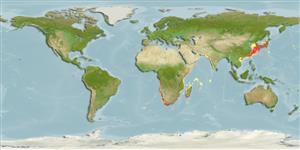Common names from other countries
Environment: milieu / climate zone / depth range / distribution range
Ecologia
marinhas bentopelágico; intervalo de profundidade 20 - 400 m (Ref. 6637). Temperate
Indo-West Pacific: Mozambique and South Africa (Ref. 6637), Japan and the East China Sea. Southeast Atlantic: Cape, South Africa (Ref. 6637).
Tamanho / Peso / Idade
Maturity: Lm ? range ? - ? cm
Max length : 150 cm TL macho/indeterminado; (Ref. 559); peso máx. Publicado: 16.1 kg (Ref. 40637)
Descrição breve
Chaves de identificação | Morfologia | Morfometria
Espinhos dorsais (total) : 9 - 10; Raios dorsais moles (total) : 13 - 14; Espinhos anais: 3; Raios anais moles: 12 - 13. Adults black in color; juveniles dusky silver.
Adults found in deep rocky areas; young found in shallow water. The diet consists of fishes, crustaceans and squids. Spawns from October to March.
Life cycle and mating behavior
Maturities | Reprodução | Spawnings | Egg(s) | Fecundities | Larvas
Heemstra, P.C., 1986. Scombropidae. p. 563. In M.M. Smith and P.C. Heemstra (eds.) Smiths' sea fishes. Springer-Verlag, Berlin. (Ref. 6637)
Categoria na Lista Vermelha da IUCN (Ref. 130435)
CITES (Ref. 128078)
Not Evaluated
Ameaça para o homem
Harmless
Utilização humana
Ferramentas
Relatórios especiais
Descarregue XML
Fontes da internet
Estimates based on models
Preferred temperature (Ref.
115969): 10.4 - 22.6, mean 18.2 (based on 218 cells).
Phylogenetic diversity index (Ref.
82804): PD
50 = 0.7500 [Uniqueness, from 0.5 = low to 2.0 = high].
Bayesian length-weight: a=0.01072 (0.00415 - 0.02764), b=3.02 (2.80 - 3.24), in cm Total Length, based on LWR estimates for this (Sub)family-body shape (Ref.
93245).
Nível Trófico (Ref.
69278): 4.2 ±0.63 se; based on food items.
Resiliência (Ref.
120179): Baixo, tempo mínimo de duplicação da população 4,5 - 14 anos (K=0.12).
Fishing Vulnerability (Ref.
59153): High to very high vulnerability (68 of 100).
